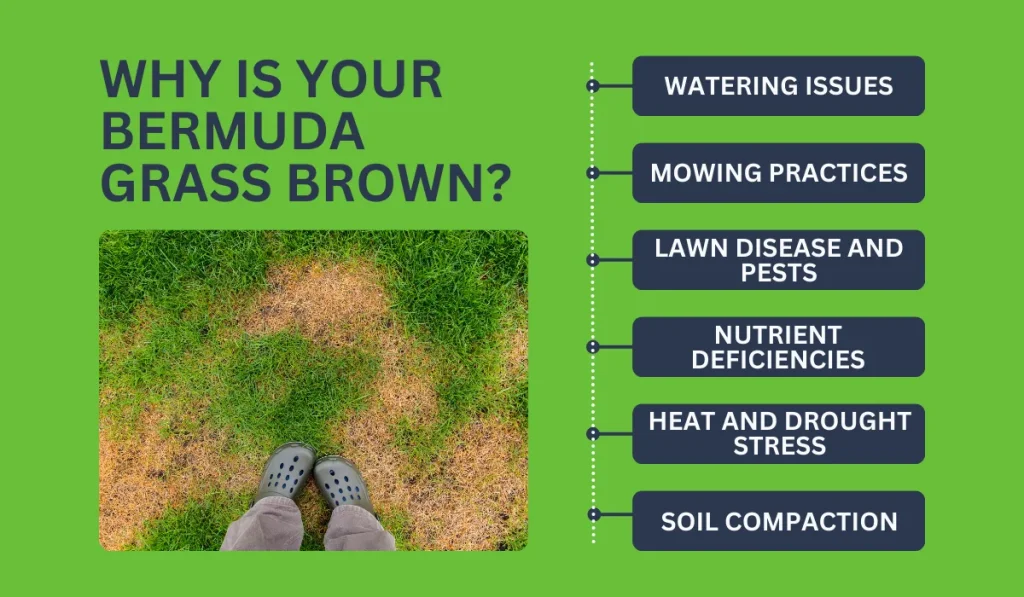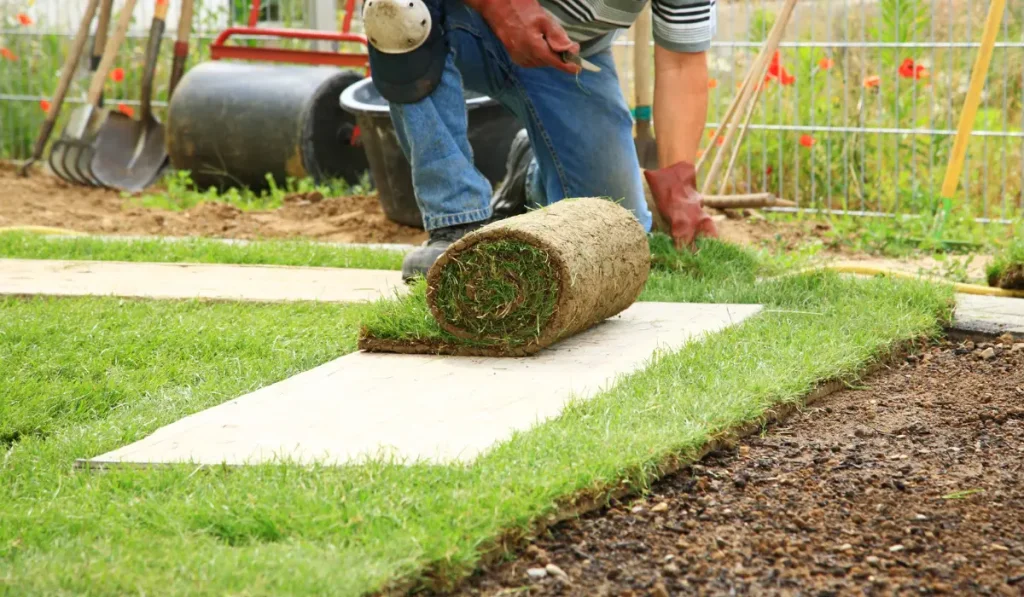Bermuda grass, known for its resilience and lush green appearance, can sometimes turn an unwelcome brown. The most common causes are water stress, fungal infections, and nutrient deficiencies.
Are you providing your lawn with the proper care and treatment to stay green and lush? Keep reading to explore each cause in detail and learn how to restore your Bermuda grass to its full glory.
Key Takeaways
- Bermuda grass browning is caused by improper watering, poor mowing, diseases, pests, and nutrient deficiencies.
- Brown patches typically result from underwatering and poor mowing habits, like cutting grass too short or using dull blades.
- Diseases such as Large Patch and Brown Patch, and pests like chinch bugs and grubs, create distinct brown patches.
- Proper nutrition and managing environmental stressors like heat and drought are vital for maintaining a healthy lawn.
- Consistent lawn care and soil testing help prevent browning and keep Bermuda grass vibrant.
Why Is Your Bermuda Grass Brown?

Bermuda grass turning brown can be a sign of various underlying problems. Identifying the specific cause helps effectively address and treat the brown patches in your lawn.
Watering Issues
Improper watering can be a prevalent cause of brown patches in Bermuda grass. Here’s how over and underwatering cause the turfgrass to turn brown:
| Considerations | Details |
|---|---|
| Underwatering | It can cause the grass to go dormant, which means it shuts down to conserve energy. |
| Overwatering | It can lead to problems like fungus growing on the roots, weakening the grass, and turning it brown. |
Mowing Practices
Mowing practices significantly impact the health of Bermuda grass. Here’s what happens when you mow too short or use dull lawn mower blades:
- Mowing too Short (Scalping): If you cut it too short (scalping), it gets weak and stressed. This makes it harder for the grass to fight off disease and stay healthy, leading to brown patches.
- Dull Mower Blades: They tear the grass instead of giving it a clean cut, which can damage the grass and make it turn brown.
Lawn Disease and Pests
Lawn diseases and pest infestations can rapidly brown your Bermuda grass. Typical lawn diseases and pests include:
| Lawn Problems | Symptoms |
|---|---|
| Large Patch Disease | Large, circular patches of brown or yellow grass, sometimes with a “doughnut” shape as the center recovers. |
| Brown Patch Disease | Circular or irregular patches of brown, wilted grass. The patches may appear “smoky” in the morning dew, with fungal webbing between blades. |
| Chinch Bugs | Areas with patchy brown grass, especially near sunny edges of the lawn. |
| Grubs | Irregular brown patches with spongy or dead patches on turf. Grubs themselves may be visible under the sod. |
Nutrient Deficiencies
Nutrient deficiencies can cause your green lawn to lose its vibrant hue. When conducting regular soil testing, ensure the right balance of nutrients by looking for the following deficiencies:
- Nitrogen Deficiency: It will cause the grass to turn pale green or yellow, with older blades showing signs first.
- Iron Deficiency: It can lead to iron chlorosis, in which new growth appears pale yellow or white, while veins may remain green.
- Magnesium Deficiency: It can cause yellowing between leaf veins, with older blades affected first. In severe cases, the entire blade may turn yellow.
- Potassium deficiency: It can cause yellowing around the edges of blades that progresses inwards, with brown scorching developing in severe cases.
Heat and Drought Stress
Bermuda grass is a warm-season grass like Zoysia, known for its heat tolerance. However, like the fescues, it has limits. It can become stressed during prolonged periods of extreme heat, especially when combined with drought conditions.
This heat stress can manifest as wilting, dormancy, and, ultimately, browning of the grass blades. Browning is a defense mechanism that conserves water and prevents further damage.
Soil Compaction
Healthy Bermuda grass needs air and water to reach its roots for proper growth. The spaces between soil particles shrink when soil becomes compacted due to heavy foot traffic, construction debris, or clay-heavy soil.
This restricts air and water movement, hindering root system development and nutrient uptake. Stagnant water around the roots can also lead to root rot, further damaging the grass and causing brown spots or patches.
How to Restore Your Bermuda Grass
Making your Bermuda grass lush and green again involves identifying the cause of the browning and taking timely, appropriate measures to address the issue.
Identifying the Root Cause
Understanding why Bermuda grass turns brown is essential for proper restoration. For a comprehensive analysis, you should perform a series of steps:
- Perform a lawn soil test to check pH levels and nutrient content.
- Examine watering habits to ensure consistent and adequate watering.
- Inspect mowing height and blade sharpness to avoid cutting too low and keep blades sharp.
- Look for signs of disease or pests, such as lawn fungus, dead spots, or pests.
Take Action
Once the cause is identified, immediate action is crucial to restoring the grass. Begin with the following steps for a greener Bermuda grass:
| What to Do | Details |
|---|---|
| Watering | Deep, less frequent watering to promote deep roots. |
| Mowing | Maintain a medium height and keep blades sharp. |
| Nutrient Deficiencies | Use appropriate fertilizers based on soil test results. |
| Disease and Pests | Apply fungicides or pesticides if necessary. |
| Compacted Soil | Aerate the lawn to improve soil structure. |
| Overseeding Bare Spots | Use high-quality Bermuda grass seed when overseeding in early spring. |



